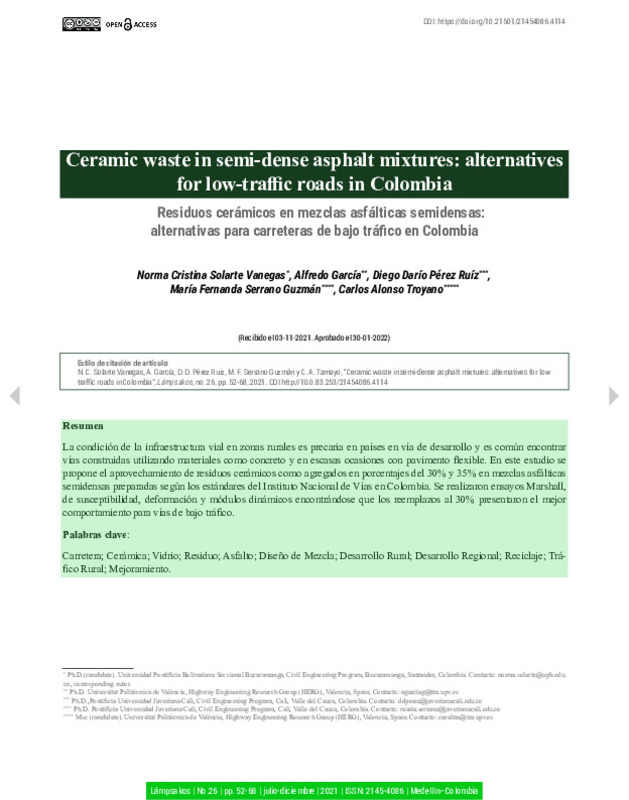|
Resumen:
|
[ES] La condición de la infraestructura vial en zonas rurales es precaria en países en vía de desarrollo y es común encontrar
vías construidas utilizando materiales como concreto y en escasas ocasiones con pavimento flexible. ...[+]
[ES] La condición de la infraestructura vial en zonas rurales es precaria en países en vía de desarrollo y es común encontrar
vías construidas utilizando materiales como concreto y en escasas ocasiones con pavimento flexible. En este estudio se
propone el aprovechamiento de residuos cerámicos como agregados en porcentajes del 30% y 35% en mezclas asfálticas
semidensas preparadas según los estándares del Instituto Nacional de Vías en Colombia. Se realizaron ensayos Marshall,
de susceptibilidad, deformación y módulos dinámicos encontrándose que los reemplazos al 30% presentaron el mejor
comportamiento para vías de bajo tráfico.
[-]
[EN] The world population has shown an exponential growth
[1] affecting the consumption of resources and therefore,
the production of waste with the consequent problems
associated with the disposal. That is the case in ...[+]
[EN] The world population has shown an exponential growth
[1] affecting the consumption of resources and therefore,
the production of waste with the consequent problems
associated with the disposal. That is the case in Colombia,
where at least 22,270,338 tons of construction and
demolition waste per capita are produced per year [2].
This country is behind several developing countries
regarding density, specifications, and maintenance of
the road system, affecting not only people¿s quality
of life but also causing lost revenues [3]. Because of
that, government agencies are encouraged to invest in
public works [4] as such as highways, hospitals, schools,
housing, sewer systems, waste water treatment systems,
water supply systems, among many others [5]. It is a
fact that transportation infrastructure is key to ensuring
the development of economic and social activities and
the cohesion of populations [6], however, the design and
construction of these projects face difficult challenges
such as shortage of materials.
Due to this fact, alternatives such as the return of
materials to the production processes have emerged [7],
recycling, reusal, disposal of non-recoverable material,
the consumption of recycled material prepared with
an industrial treatment, the reduction of resource
consumption, [7] among other initiatives, are being used
in the improvement of pavements. It should be noted that
various methods can be used for the conditioning of the
coating, such as hot dense mixes, hot open mixes, hot
demi-dense mixes. This study focuses on the analysis
of the behavior of hot dense mixtures in which ceramic
industrial waste has been introduced. It must be made clear
that in recycling new products are made [8] while in reuse,
the same product is reused several times during multiple
uses [9]. Considering that the activities of construction,
maintenance and rehabilitation of roads depend on nonrenewable
resources [7], the incorporation of certain waste
in road construction processes can generate significant
benefits.
For example, waste and plastic residues have been used
as a modifier in asphalt mixtures [10] and ceramic residues
[11][12] with results that have shown up to 13.5% higher
elastic modulus than a conventional asphalt mixture [13].
It is irrefutable that the progress of a region evidenced
by different aspects and connectivity conditions makes
part of them [14].
This connectivity is achieved by different terrestrial,
aquatic, or aerial means, but terrestrial means
consisting of roads and unpaved roads are the most
common. Around 90% of the roads worldwide are paved
using asphalt [15], which is why the consumption of
different types of this product reaches 100M t annually
worldwide [7].
In the case of Colombia, a developing country, the
armed conflict for over a period close to six decades
[16] has had an impact on socio-economic, political,
and cultural conditions [17] mainly in the rural areas
where around 60% of the population is located, they are
to use tertiary roads in order to reach the main roads
through the [18] [14].
The objective of this research is to evaluate the
mechanical behavior of hot semi-dense asphalt
mixtures prepared with the replacement of 30% and 35%
of stone material with ceramic waste. This alternative
is presented as a solution for the disposal of this kind of
waste in Colombia and for the improvement of mobility
conditions on low traffic roads. The study responds
to questions about the compatibility of the use of
these waste as aggregate for binder by standardizing
mechanical tests that allow the validation of the use in
asphalt mixtures.
[-]
|









